If you want to know about the Egyptian architecture or roman architecture or gothic architecture, please click the link.
Byzantine architecture is the architecture of the byzantine empire. The empire gradually emerged as a distinct artistic and cultural entity from what is today referred to as the roman empire after ad 330, when the roman emperor Constantine moved the capital of the roman empire east from Rome to Byzantium.
Byzantium, “new Rome”, was later renamed Constantinople and is now called Istanbul. The empire endured for more than a millennium, dramatically influencing medieval and renaissance era architecture in Europe and, following the capture of Constantinople by the ottoman Turks in 1453, leading directly to the architecture of the ottoman empire.
Early byzantine architecture was built as a continuation of roman architecture stylistic drift technological advancement, and political and territorial changes meant that a distinct style gradually emerged which imbued certain influences from the near east and used the Greek cross plan in church architecture.
Buildings increased in geometric complexity, brick and plaster were used in addition to stone in the decoration of important public structures, classical orders were used more freely, mosaics replaced carved decoration, complex domes rested upon massive piers, and windows filtered light through thin sheets of alabaster to softly illuminate interiors.
1) Influences
Historical Background
- Fierce barbaric tribes such as the Goths and Vandals attacked from outside the empire
- In 285 – 293 AD, the empire had split into two – an Eastern and Western empire
- Constantine, a converted Christian, changed the capital of the Empire from Rome to Constantinople in 330 AD
- The western empire based in Rome finally collapsed in 476 AD
- Eastern empire lasted another thousand years and was known as the Byzantine empire
- Constantinople stood on the site of an old Greek town called Byzantium (present-day Istanbul)
- Known as the “new Rome”, most commanding position and most valuable part of eastern Roman empire
- Bulwark of Christianity during the Middle Ages
- Strongly Christian people – founded many monasteries and churches
- Converted the Russians and Eastern Europeans to Christianity – this form of Christianity survives today as the Eastern Orthodox Church
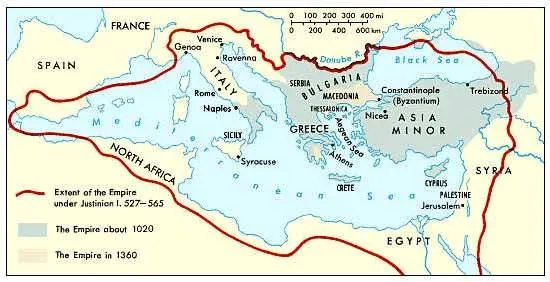
- By the time Constantine became the Caesar of Roman Empire, the empire had split in half.
- The western roman empire cantered in Rome and eastern empire in Byzantium.
- Under Justinian the Great the eastern empire became very strong and stable by the 6th century.
- Byzantium was captured by Turks of ottoman invaders in 1453 and converted to Istanbul subsequently.
Geographical Factors

- Occupies an important commercial site, standing at the intersection of the two great highways of commerce the water highroad from the Black Sea into the Mediterranean, and the land highroad from Asia into Europe; a position which, from early times, gave it power and influence.
- Where Asia and Europe meet, separated by a narrow strip of water
Geological Influences
- Possessed no good building stone or even material for making good bricks.
- Most of the marble used in the new capital was brought from different quarries round the Eastern Mediterranean, for Constantinople was a marble working centre from which sculptured marbles were exported to all parts of the Roman world.
- Art and architecture executed by original Greek craftsmen
- Influence reached Greece, Serbia, Russia, Asia Minor, North Africa, further west

Climatic Conditions
- Being hotter than Rome, and to its being further east, the Romans on settling there altered their method of building to suit the novel conditions due to the climate.
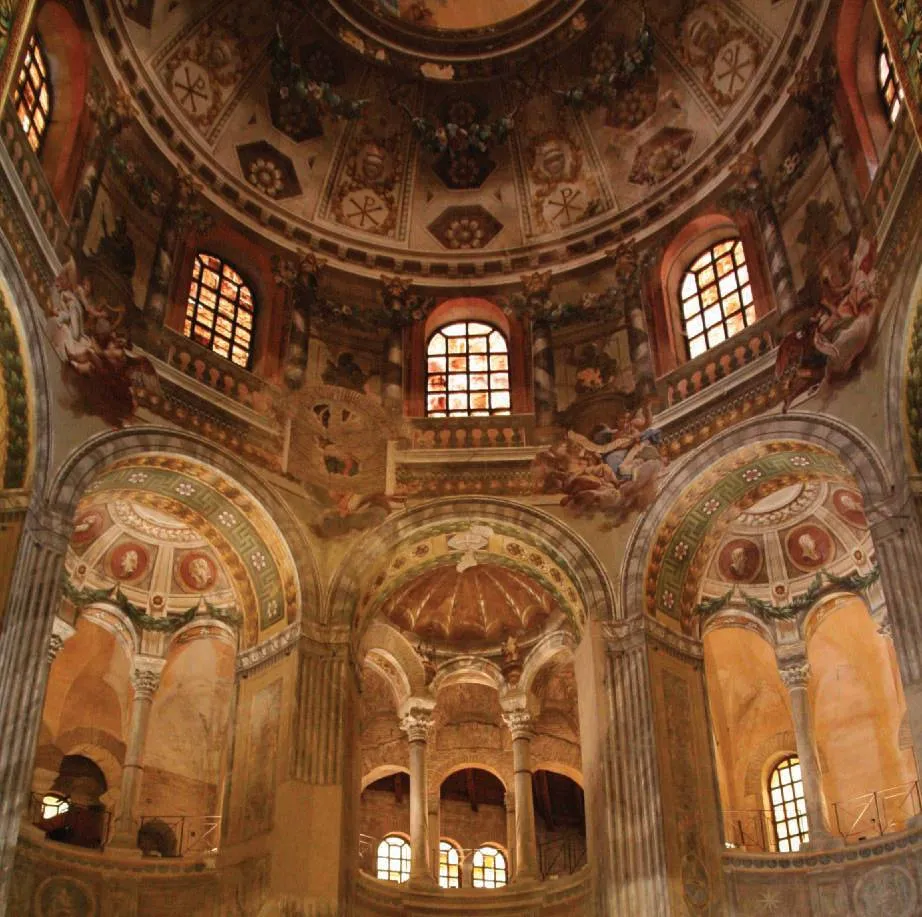
2) Architectural character
- Domed Basilica Churches and Greek Cross plan Churches.
- Characterized especially by massive domes with square bases and rounded arches and spires.
- Buildings increased in complexity, brick and plaster were used in addition to stone in the Decoration
- The regular entablatures of the Romans were abandoned and arches were employed.
- Classical orders were used more freely.
- Mosaics decorations on walls and floors.
- Grouped Windows filtered light through which softly illuminate interiors.
Plans
- Byzantine churches are all distinguished by a great central square space covered with a dome, supported by means of pendentives.
- On each side extend short arms, forming a Greek cross, which with the narthex and side galleries make the plan nearly square.
- The leading idea in an Early Christian Basilica is horizontal, by means of the long perspective of central one, towards which the eye columns, which direct the eye is drawn.
- The leading thought in a Byzantine church is vertical, by the grouping of domes round a principal central one.

Walls
- These were often constructed of brick with the core of the wall was generally of concrete.
- Internally, all the oriental love of magnificence was developed, marble casing and mosaic being applied to the walls
- Absence of mouldings prevailed.
- Externally the buildings were left comparatively plain, although the façade was sometimes relieved by alternate rows of stone and brick, in various colors.

Openings
- Doors and windows are semicircular headed.
- The windows are small and grouped together.
- The churches depend largely for light on the ring of windows at the base of the dome, or in the “drum”.
- In the bright climate very much smaller openings sufficed to admit the necessary light.
- The universal employment of mosaic in Byzantine churches and the consequent exclusion of painted glass, rendered the use of such large windows.

Roofs
- Domes formed in brick, stone, or concrete, with frequently no further external covering.
- The Byzantines introduced the dome placed over a square or octagonal plan by means of pendentives
- The early domes were very flat; in later times they were raised on a drum or cylinder.

Byzantine dome construction
- The dome was the prevailing motif of Byzantine architecture
- Practice of using domes contrasts with Early Christian timber truss system
- How to put a round dome on flat walls: use a PENDENTIVE!


- Three types of dome:
- Simple – Pendentives and domes are of same sphere
- Compound – Dome of separate sphere, rises independently over sphere of pendentives or dome raised on high drum
- Special designs – melon, serrated, onion or bulbous shape
Construction system
- Fusion of domical construction with classical columnar style
- Domes of various types placed over square compartments using pendentives
- Semi-circular arches rest directly on columns, with capitals able to support springing of arches
Columns
- In the earlier buildings, these were taken from ancient structures soon the supply was exhausted.
- Capitals sometimes took a form derived from the Roman Ionic or Corinthian types.
- Columns were introduced to support galleries, the massive piers alone supporting the superstructure.
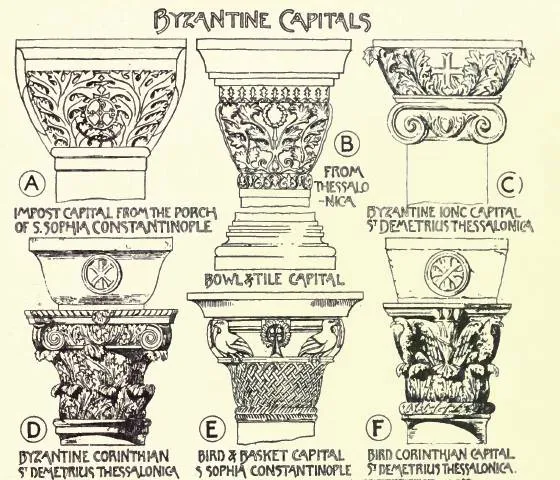
Mouldings
- These were unimportant, their place being taken by broad flat expanses of wall surfaces.
- Internally, the decorative lining of marble and mosaic in panels was sometimes framed in mouldings, but generally flat ornamentation were used.
- Externally, the simple treatment of the elevations in flat expanses of brickwork, with occasional stone banded courses, did not leave the same scope for mouldings as in other styles.
Ornamentation
- The walls being lined with costly marbles to form patterns, and the vaults and upper part of walls with glass mosaic having symbolic figures.
- Mosaic thus was used in a broad way as a complete lining to a rough structure, and architectural lines were replaced by decorative bands in the mosaic.
- The gold surfaces being continued as a background to the figures, unity of surface is always maintained.
- Greek technique was followed in the carving, a special character of the carving was due to the use of the drill instead of the chisel.
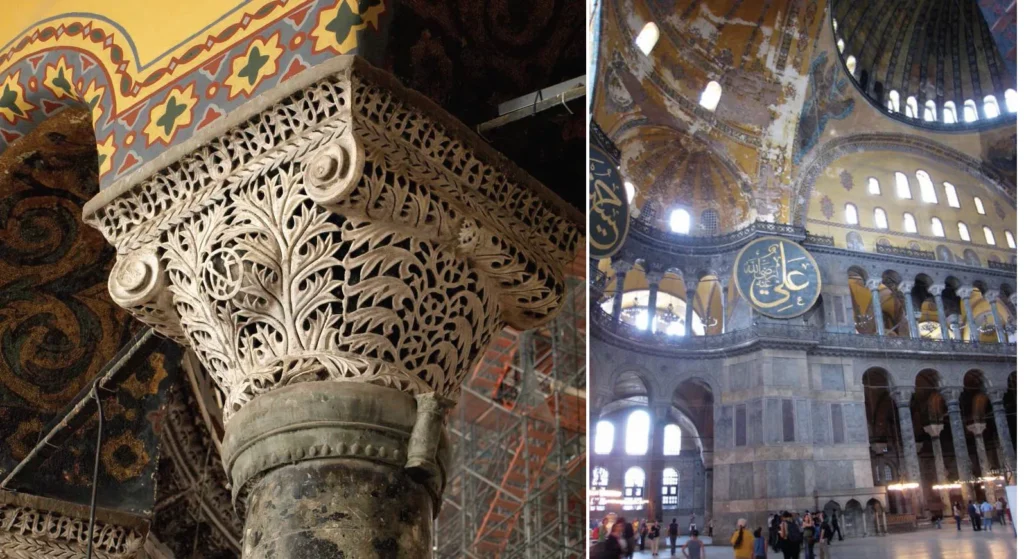
Mosaics
- Mosaics were a very permanent wall & floor decoration feature.
- Mosaic is decoration using pieces of stone, marble, or colored glass are cemented to a wall or floor.

3) Examples of byzantine architecture
- Hagia sophia
- Dome on the rock, jeruselum
- Umayyad mosque , damascus
Haggia sophia , Istanbul
- Emperor Justinian hired ten thousand skilled craftsmen to complete hagia Sophia. There were stonecutters, brick masons, carpenters, glassblowers, marble workers, sculptors, goldsmiths, and other artists. Only the finest materials were used for the interior of the church. Red, green, and white marble covered the floors and walls. Ivory, silver and gold decorated carved wooden doors. Silk hangings, from the newly established silk weaving industry in Constantinople, decorated the doorways. Justinian wanted to pave the sanctuary floor in silver but was talked out of doing so by his advisors. They pointed out that such a costly floor could be pried up by future emperors, if they needed money.

- Problems with hagia sophia
- Because of Justinian’s impatience to finish the church, the structure of hagia Sophia suffered. Bricklayers used more mortar than bricks when building the outer walls, and they often did not wait for one layer of mortar to dry before starting the next layer. The results were walls that bowed out slightly. These uneven walls would not support the massive weight of the great dome. In 557, an earthquake caused the dome to collapse. When it was rebuilt, architects made the dome twenty feet higher, bringing it up to its current height of 184 feet. The weakened walls were also repaired to give the new dome proper support.
- The end of an empire
- When constantinople fell to the ottoman turks in 1453, hagia sophia, one of the greatest symbols of christianity, was converted to an islamic mosque. Because pictures of living creatures are forbidden in islam, the beautiful mosaics that adorned the walls and ceilings of hagia sophia were covered over by plaster. In place of the mosaics, muslim artists painted beautiful islamic symbols and calligraphy. Over the next six hundred years, many changes were made to hagia sophia. Four minarets, or towers, were added, one at a time. From these minarets a muezzin, or caller, would call all the muslims of constantinople, now called istanbul, to prayer five times a day. In 1935, hagia sophia was converted into a museum by the government of the new republic of turkey. Called the ayasofya museum, it is open to visitors from all over the world every day, except mondays.

- Hagia Sophia “divine or holy wisdom”
- Built by Justinian, designed by Anthemius of Tralles and Isidorus of Miletus
- Rose on the site of 2 successive Basilican churches of the same name
- Most important church in Constantinople
- Perfection of Byzantine style
- Later converted into a mosque
Dome on the rock, jeruselum

- Byzantine and Islamic architecture share a common trend: that is, the use of the dome.
- One example is the dome of the rock in Jerusalem, which was Islamic architecture, but illustrates the influence byzantine bestowed as the dome style passed on to the Muslims.
- They often used “Persian’ dome. We modernly refer to this as the onion dome.
- The most celebrated example is the taj mahal (A.D. 1630) at Agra, India.
- Byzantine’s advancement in developing the dome created a new style in global architecture, for no other civilization had designed buildings, especially religious buildings, as did the Byzantines.
Umayaad mosque, Damascus
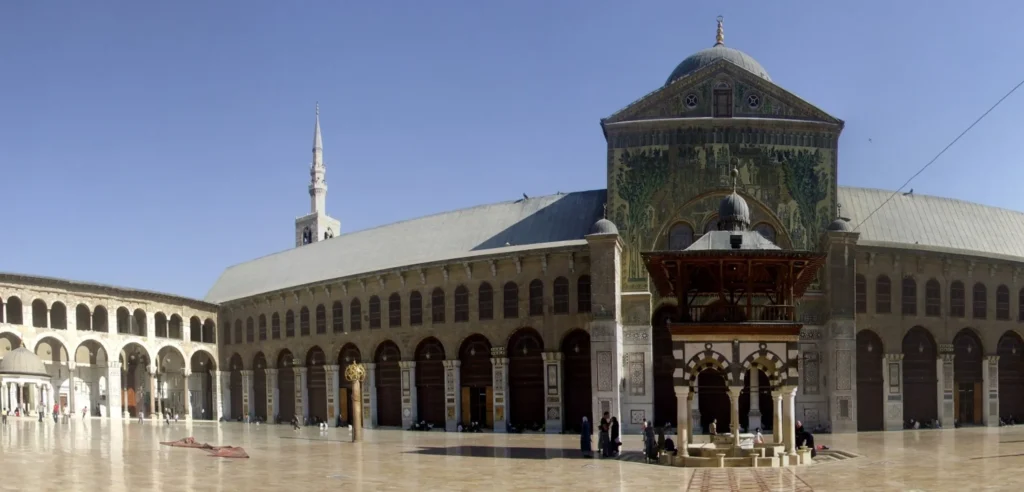
S. Mark, Venice

- Begun in 1063 to replace an earlier church destroyed by fire.
- Received through several centuries additions not always Byzantine in character.
- The picturesque but wholly unstructural use of columns in the entrance porches, the upper parts of facades and the pointed arches are deviations from byzantine traditions
- It is based on a typical Greek cross plan
- Each arm has a dome of it’s own
- Each arm has a central aisle and two side aisles.
- A narthex wrapped around the west end disguises the cross shape but creates a wide, flat surface for the grand facade.
- The interior is richly veneered with colored marbles casing the lower part of the walls.
- Above, and extending in one great surface over vault and dome, is a lining of richly colored glass mosaic, in which are worked figures of saints set off by a broad background of gold. Mosaic, in fact, is the real and essential decoration of the church, to which all architectural detail is subordinated.
- The external facade has five entrances, enriched with shafts of many-colored marbles forming a rich and beautiful portal.
- Mosaic panels also serve to enrich with color the spandrels of the arches. The effects of depend not only upon the most delicate sculpture in every part, but also on the most subtle/variable, inexpressible color produced by transparent alabaster, polished marble, and lustrous gold.
The Byzantine style spread over Greece, Russia, and other parts, and has been the accepted style of the Greek church to the present day.